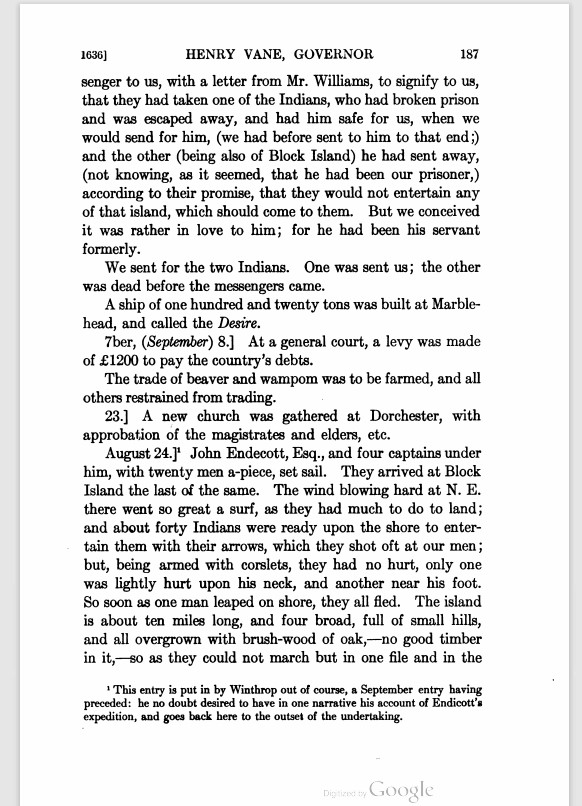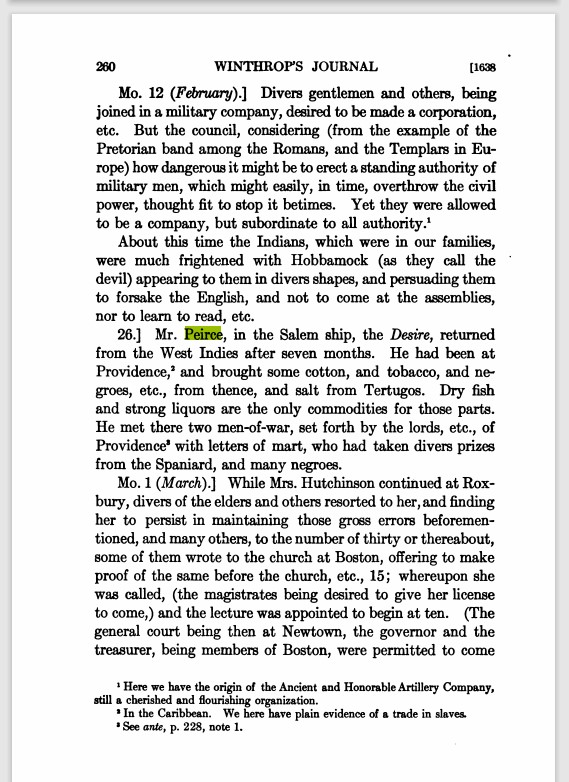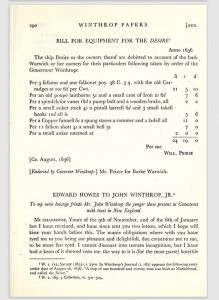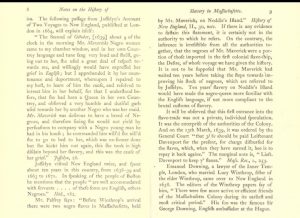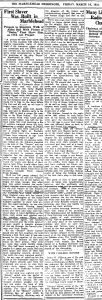Built in Marblehead in 1636, the 120-ton Desire is commonly believe to be one of the first ships to bring enslaved Africans into the Massachusetts Bay Colony. Built to serve many purposes, the ship carried passengers, trade goods, and supplies throughout the Atlantic World. It also served to traffic in people. The papers and journals of John Winthrop, which provide the only extant contemporaneous information of the vessel and its connections to the slave trade, detail some of the vessel's journeys. In July 1637, William Peirce, master of the Desire, left Massachusetts Bay Colony for Bermuda to sell into slavery 15 Native boys and 2 Native women captured in battle near what is now New Haven [227-228]. In February of the next year, Peirce and the Desire returned from Providence Island in the West Indies with a hold full of "some cotton, and tobacco, and negroes, etc." [260].
John Winthrop's Journal
James Kendall Hosmer, LL. D., ed. Original Narratives of Early American History: Winthrop’s Journals “History of New England,” 1630-1649. Volume I. New York: Charles Scribner’s Sons, 1908. Pages 187, 260, 331. Google Books.
John Winthrop's Papers
Massachusetts Historical Society. Winthrop Papers, Volume III (1631-1637). Boston: Merrymount Press, 1943. Page 290. Archive.org
Notes on the History of Slavery in Massachusetts by George Henry Moore
This text, published in 1866, draws on numerous sources. Moore argues that the enslaved people brought to the Mass Bay Colony by the Desire may have been the same that Maverick cruelly exploited. There appears to be no concrete evidence given to support this supposition.
George Henry Moore. Notes on the History of Slavery in Massachusetts. New York: D. Appleton & Co., 1866. Pages 6-9. Archive.org
"First Slaver Was Built in Marblehead." Marblehead Messenger
Though this article tends toward narrative flourishes rather than historical fact, it is telling that the townspeople of 1930's Marblehead considered the Desire worthy of a montage on the walls of Abbot Hall with the other important moments in the town's early history. Indeed, in this article, there is even a sense of pride in Marblehead's role in the early shipbuilding and shipping of the colony, despite its direct association with the founding of the slave trade in Massachusetts.
Also worthy of note: the Desire was not build as a "slaver." It was a cargo ship also used for carrying Natives and Africans into slavery, but unlike later vessels, its sole purpose was not for carrying human cargo. Therefore, we refer to it as a vessel that carried enslaved people rather than a "slave ship" or "slaver."
"First Slaver was Built in Marblehead." Marblehead Messenger. March 16, 1934. Page 2.
Who was William Peirce, Master of the Desire?
This document charts some of the genealogical and professional information about William Peirce, the sea captain, and compares it to a William Peirce of the Virginia Colony. Marblehead Museum Collection.
See Also:
Winthrop Town Memorials - William Pierce
Captain William Peirce - Early Boston Booksellers 1642-1711, George Emery Littlefield, 1900, pg. 32, Google ebook.
Captain William Peirce (or Perise) - The Pilgrim Republic: An Historical Review of the Colony of New Plymouth, John Abbot Goodwin, 1888, pg. 471, Google ebook.
Further Reading
"First Slaves Arrive in Massachusetts. Mass Moments. https://www.massmoments.org/moment-details/first-slaves-arrive-in-massachusetts.html. Accessed 1.13.2021.
Virginia Clegg Gamage & Priscilla Sawyer Lord. Marblehead: The Spirit of '76 Lives Here. Chilton Book Company, 1972.
Samuel Roads, Jr. The History & Traditions of Marblehead. Third Edition. Marblehead: N. Allen Lindsey & Co., 1897. See page 12.
